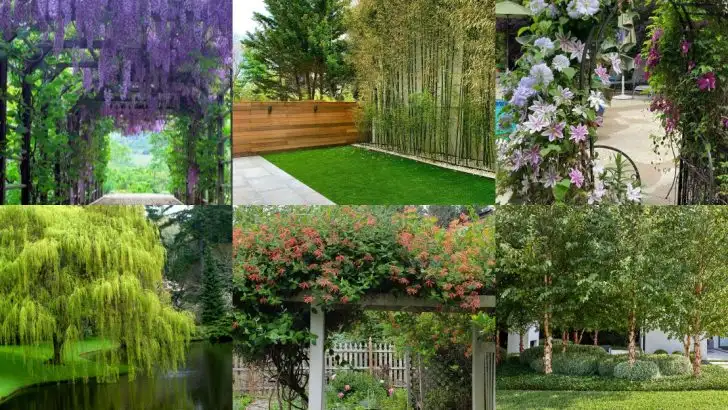Who says you need concrete and timber to build a masterpiece? Your garden can have rooms, hallways, doorways—even a leafy ceiling—without a single trip to the hardware store. These plants don’t just fill space. They shape it. They arch, spill, tower, and curtain, turning flat backyards into layered, living escapes. Imagine stepping through a doorway of jasmine, sitting beneath a canopy of lacy foliage, or wandering through a corridor of blooming columns—all grown, not built. This is garden architecture the way nature intended: no noise, no permits, just beauty and patience. Let’s dig into the 17 plants that know how to build.
Wisteria
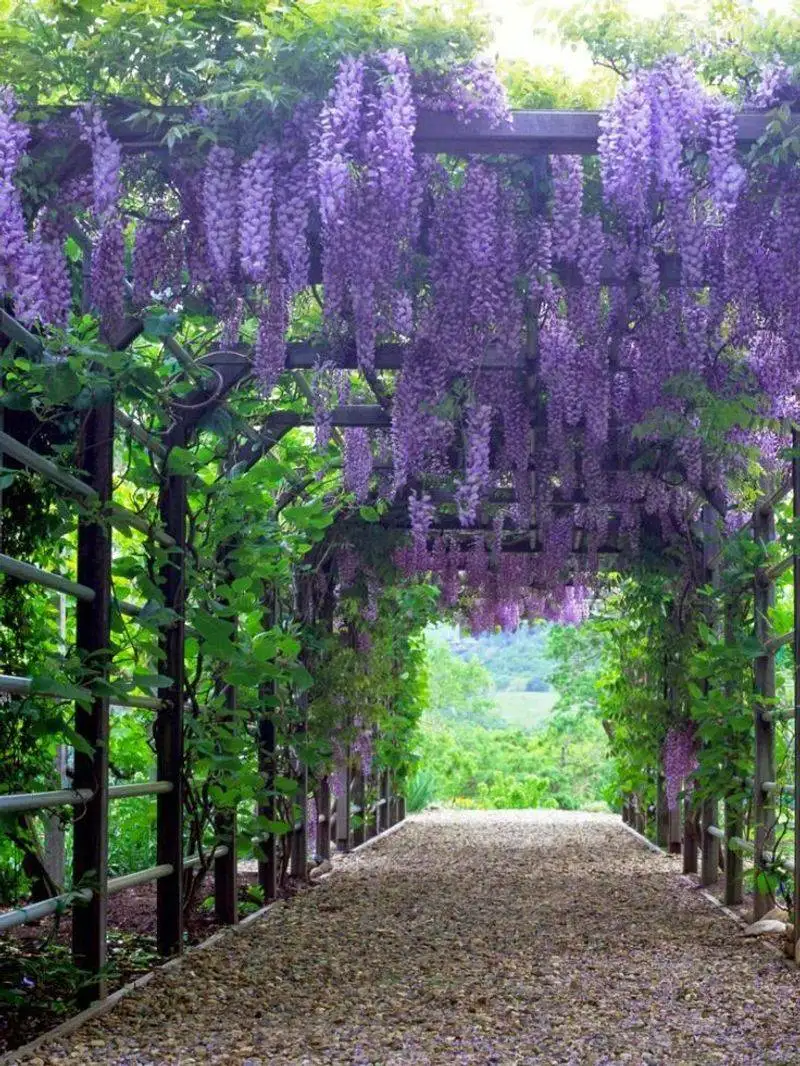
Wisteria’s enchanting blooms are like nature’s own curtains, transforming any garden arch into a floral masterpiece. Its cascading purple flowers exude a dreamy elegance, swaying gently with the breeze. Perfect for creating a romantic doorway, wisteria vines twist and twirl, offering a fragrant welcome to all who enter.
Imagine walking through a tunnel of blossoms, each step accompanied by the soft rustle of leaves. This deciduous vine thrives in sunny spots, requiring minimal care once established. Its spirited growth ensures a lush, flowery archway year after year.
Bamboo
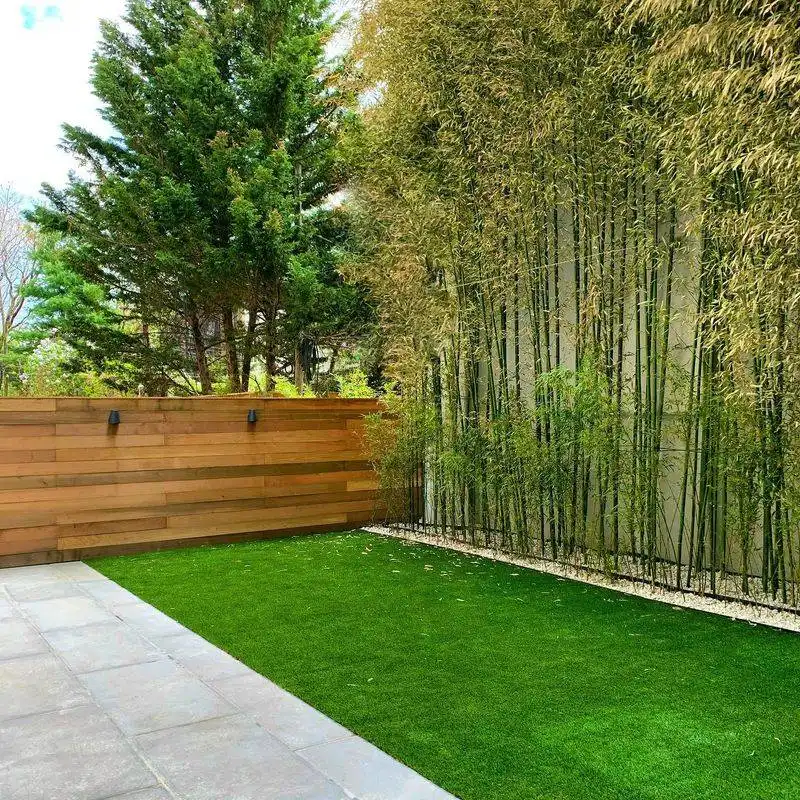
Bamboo stands tall and proud, forming natural partitions that can transform open spaces into secluded retreats. Its rapid growth and striking vertical lines make it a favorite for creating garden rooms. The rustle of bamboo leaves in the wind adds a serene backdrop to any outdoor setting.
Beyond its beauty, bamboo is a sustainable choice, regenerating quickly and requiring little maintenance. Choose clumping varieties for a more controlled spread, and plant in well-drained soil. Whether lining a path or defining a boundary, bamboo’s presence is both bold and calming.
Clematis
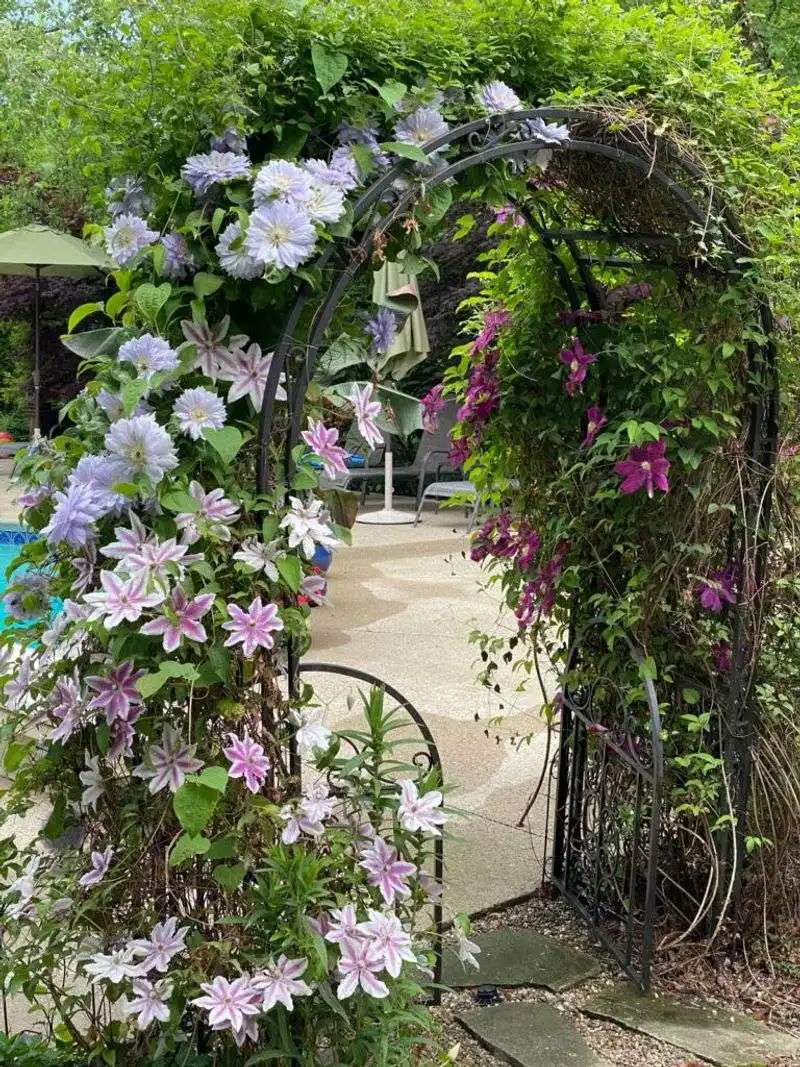
Clematis, with its kaleidoscope of colors, effortlessly climbs trellises to craft stunning vertical displays. Its large blooms, in varying hues from deep purple to soft pink, bring a lively touch to any garden.
This vine is adept at creating floral curtains, transforming plain structures into vibrant works of art. Perfect for small spaces, clematis can be trained to form unique patterns, adding an artistic flair. Pair it with sturdy supports and watch it flourish in well-drained soil. Its ability to reinvent garden spaces is truly unmatched.
Weeping Willow
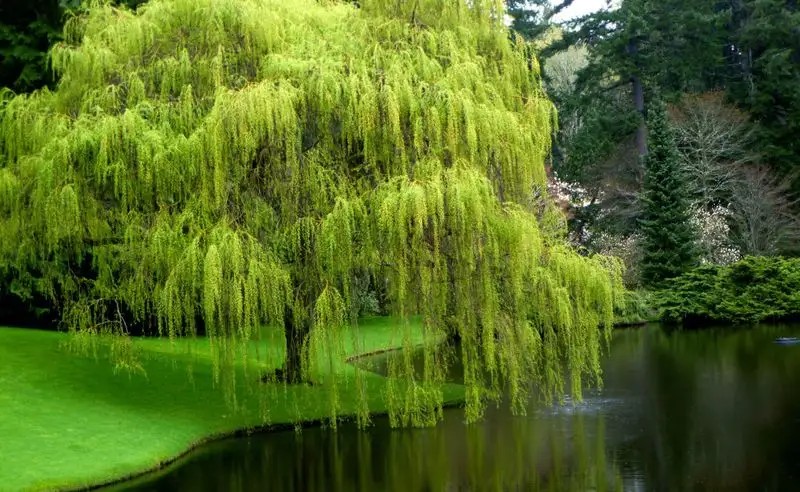
The weeping willow’s graceful branches cascade like a gentle waterfall, crafting natural ceilings in expansive gardens. Its sweeping limbs provide a shaded sanctuary, perfect for relaxation and reflection. As the wind whispers through its leaves, a sense of peace envelops the space.
This tree, with its elegant form, is an iconic choice for waterside planting. It thrives in moist conditions, its roots extending to quench its thirst. A weeping willow not only beautifies but also brings a touch of serenity, turning any landscape into an idyllic retreat.
Honeysuckle
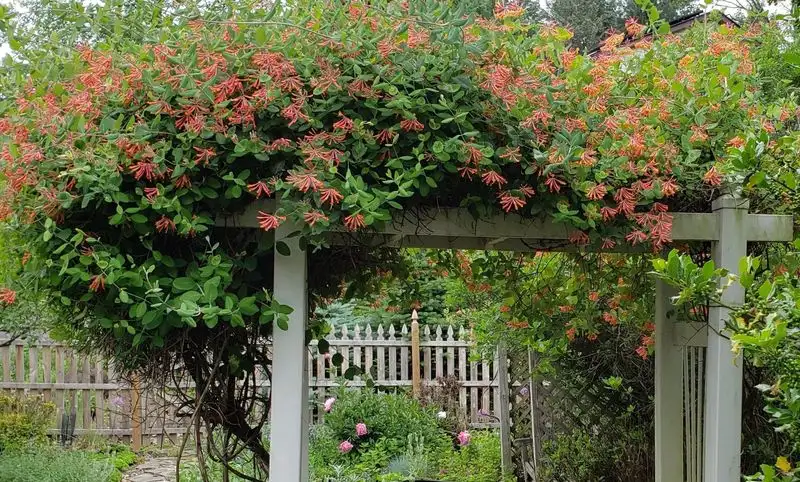
Honeysuckle is a sensory delight, its fragrant blooms painting fences and arbors with vibrant hues. This vigorous climber is ideal for crafting scented doorways, blending color and aroma in perfect harmony.
Its blossoms attract hummingbirds and butterflies, adding life and movement to the garden. With varieties that bloom from spring to fall, honeysuckle provides a long-lasting display. Easy to grow and maintain, it prefers a spot with morning sun and afternoon shade. Let its sweet scent guide you through enchanting garden passages.
Birch Trees
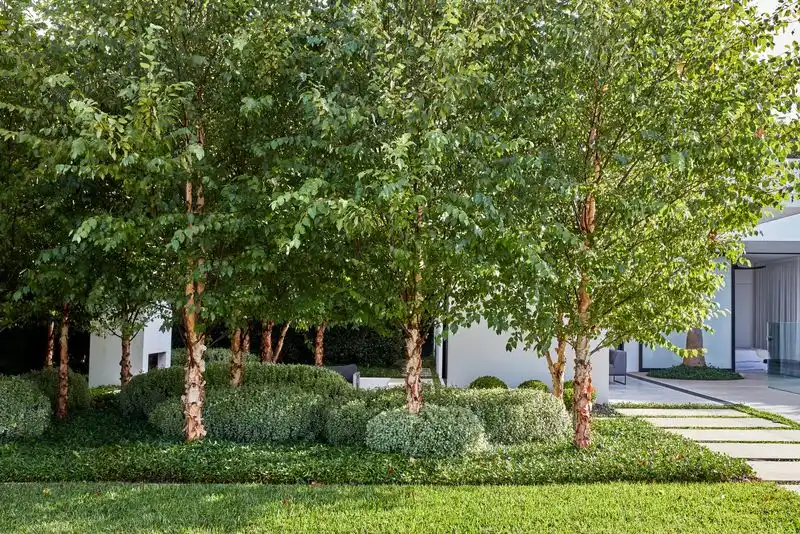
Birch trees bring a touch of elegance with their striking white bark and delicate foliage. Planted in groups, they form natural columns that define garden spaces with grace. Their leaves flutter in the breeze, casting playful shadows on the ground.
These trees are perfect for creating airy partitions or lining pathways. Birch thrives in various soil types but prefers slightly acidic conditions. Their seasonal beauty peaks in autumn when leaves turn golden yellow. Birch trees are not just trees; they are living sculptures that enhance any garden’s architecture.
English Ivy

English ivy brings an air of mystery, cloaking walls and structures in a lush, green tapestry. Its ability to climb and cling makes it ideal for creating natural walls and ceilings. The deep green foliage remains vibrant year-round, providing consistent beauty.
This hardy vine is versatile, thriving in both sun and shade. It requires minimal maintenance once established, making it a gardener’s ally for effortless elegance. Whether covering an old stone wall or forming a verdant canopy, English ivy transforms ordinary spaces into enchanting retreats.
Bougainvillea
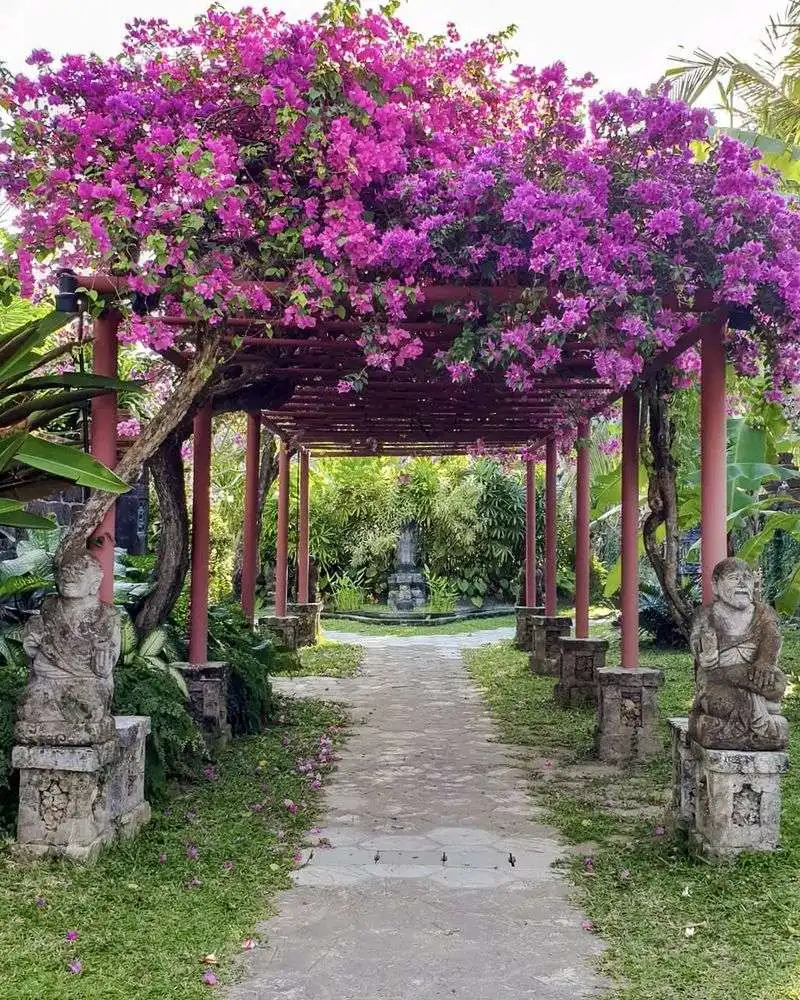
Bougainvillea is a burst of color, draping pergolas and trellises with its vivid blooms. Its papery bracts, in hues of magenta, orange, and white, create striking visual displays. This sun-loving plant thrives in warm climates, adding a tropical flair to any garden.
Ideal for covering large areas, bougainvillea grows vigorously and can be shaped to fit various structures. Its thorny nature serves as a natural barrier, combining beauty with security. With minimal care, it rewards gardeners with a perpetual show of color and vitality.
Japanese Maple

Japanese maple, with its intricate leaves and vibrant hues, creates stunning garden ceilings. Its graceful branches arch elegantly, forming a natural canopy that offers shelter and shade. Renowned for its autumnal display, its foliage transforms into a fiery palette of reds and oranges.
This ornamental tree thrives in well-drained soil and partial shade. Its compact size makes it ideal for small gardens, adding a splash of color and texture. Japanese maple is more than a tree; it’s a work of art that brings elegance and tranquility to any outdoor space.
Lavender

Lavender’s aromatic flowers and silvery foliage create soothing garden paths and borders. This perennial plant fills the air with its calming scent, inviting relaxation and tranquility. Its vibrant purple spikes add color and contrast to garden designs.
Lavender is a sun-loving plant, thriving in well-drained soil with minimal water needs. It attracts pollinators, enhancing garden biodiversity. Prune regularly to maintain its shape and encourage new growth. Whether lining a walkway or creating a fragrant border, lavender’s charm is both visual and olfactory.
Rosemary

Rosemary offers both culinary delight and architectural charm, with its aromatic foliage and delicate flowers. This evergreen shrub forms dense, sculptural hedges that can frame pathways or create intimate garden rooms.
Its needle-like leaves release a refreshing scent, enhancing sensory experiences. Rosemary thrives in sunny locations with well-drained soil, requiring little water once established. Regular pruning keeps it tidy and encourages bushier growth. More than a kitchen staple, rosemary adds structure and fragrance, weaving practicality with beauty in garden design.
Vine Maple

Vine maple, with its twisting branches, creates enchanting overhead structures and canopies. Its vibrant autumn display, with leaves turning fiery orange and red, adds seasonal interest.
This native tree is well-suited for woodland gardens, thriving in partial shade and moist soil. Its compact size makes it a versatile choice for small gardens, offering privacy and visual intrigue. Vine maple’s unique form and changing colors make it a dynamic addition to any garden, providing both beauty and function year-round.
Climbing Roses

Climbing roses transform ordinary spaces into romantic havens, their cascading blooms a feast for the eyes. These vigorous climbers adorn arches and trellises, creating fragrant doorways and floral ceilings.
With varieties blooming throughout the season, climbing roses offer continuous color and scent. They thrive in sunny locations with fertile soil. Regular pruning encourages healthy growth and abundant blooms. Beyond their visual appeal, climbing roses are symbols of timeless beauty, crafting elegant structures in any garden they grace.
Golden Chain Tree
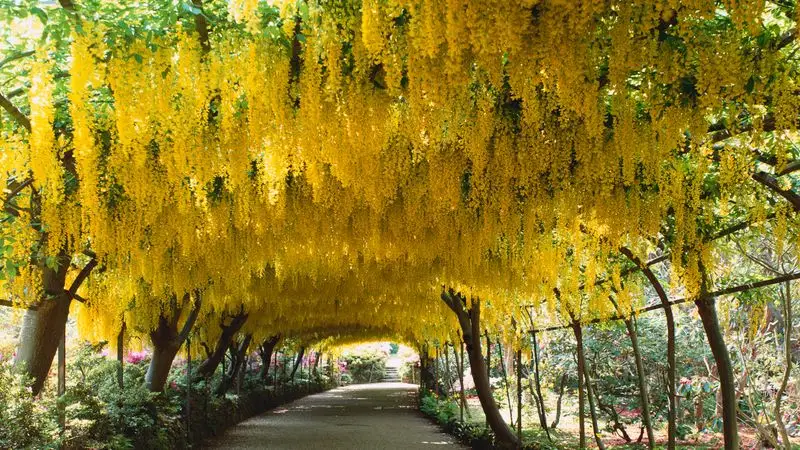
The golden chain tree dazzles with its hanging clusters of bright yellow flowers, creating golden arches and canopies. This ornamental tree is perfect for adding a touch of elegance and spectacle to garden designs.
Blooming in late spring, its vibrant flowers attract pollinators and admiration alike. It prefers sunny locations and well-drained soil. The golden chain tree’s dramatic display is complemented by its graceful form, making it a standout feature in any landscape. This tree’s beauty lies in its ability to transform ordinary spaces into extraordinary ones.
Boxwood

Boxwood, with its dense foliage, is the quintessential plant for creating structured garden rooms. Its versatility allows for endless design possibilities, from simple borders to intricate parterres.
This evergreen shrub thrives in well-drained soil and can adapt to both sun and shade. Regular trimming keeps its shape crisp and defined, making it a favorite for topiary and formal gardens. Beyond aesthetics, boxwood provides a sense of order and refinement. It’s a living testament to the art of garden design, blending history with modern creativity.
Ferns

Ferns, with their feathery fronds, bring a prehistoric beauty to shaded gardens. Their lush green foliage creates a soft, textured carpet, perfect for ground cover or under-planting.
Thriving in moist, shaded environments, ferns require minimal care once established. Their ability to adapt makes them ideal for covering bare ground or filling gaps between larger plants. Beyond their visual appeal, ferns offer a sense of tranquility and natural elegance. Whether in a woodland setting or urban garden, ferns add a touch of wild beauty and serenity.
Grapevines
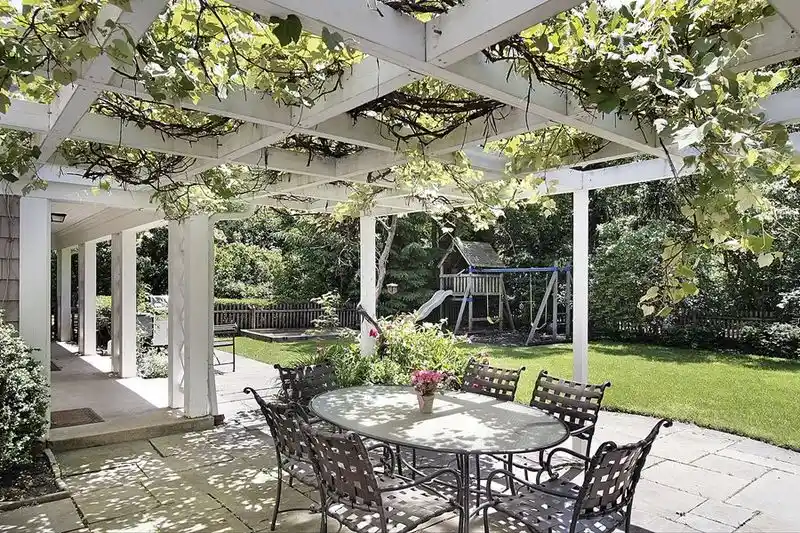
Grapevines bring a Mediterranean charm, their curling tendrils and lush leaves creating inviting green ceilings and arches. Beyond their aesthetic appeal, they offer the promise of homegrown fruit, adding utility to beauty.
These vigorous climbers thrive in sunny locations with well-drained soil. Regular pruning and support are key to controlling growth and maximizing fruit yield. Grapevines transform garden spaces into productive sanctuaries, offering shade and a sense of abundance. They’re not just plants; they’re a celebration of life and growth.

